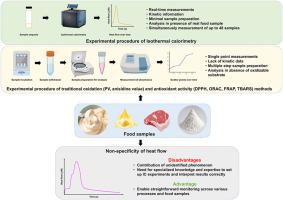Lipid oxidation kinetics and antioxidant efficiency in foods using isothermal calorimetry
IF 15.1
1区 农林科学
Q1 FOOD SCIENCE & TECHNOLOGY
引用次数: 0
Abstract
Background
Oxidative stability and antioxidant properties significantly impact the quality, shelf-life, and nutritional value of food. However, current methods for studying lipid oxidation and antioxidants face limitations including a lack of real-time monitoring, difficulties in complex food matrix assessment, limited sensitivity, and mechanistic insights. Invasive sample preparation and reliance on model systems further compound these challenges. Overcoming these limitations is essential for advancing food preservation and product development strategies.
Scope and approach
This review discusses the use of isothermal calorimetry (IC) in food science, particularly for studying lipid oxidation and antioxidant properties. It explains how IC heat flow data can provide valuable kinetic information, revealing the mechanisms of antioxidant action. Moreover, the review evaluates the advantages and limitations of IC in food science, providing insights into its potential for future research and applications.
Key findings and conclusions
IC enables real-time monitoring of lipid oxidation and antioxidant activity, offering valuable insights into their behavior in the presence of food-based oxidizable substrates. By measuring heat flow over time and applying appropriate data analysis, IC can generate key kinetic parameters that describe the rates of oxidation and the rate constants of both oxidation and inhibition reactions. Additionally, kinetic modeling allows for the assessment of antioxidant efficiency (A.E.) and oxidizability index (O.I.), which are especially useful for complex food matrices such as emulsions, encapsulated powders, and natural extracts. While IC provides direct measurement, high sensitivity, and long-term thermal stability, challenges include the non-specificity of heat flow and the requirement for specialized expertise to set up and interpret experiments accurately.

利用等温量热法测定食品中的脂质氧化动力学和抗氧化效率
背景氧化稳定性和抗氧化特性对食品的质量、保质期和营养价值有重大影响。然而,目前研究脂质氧化和抗氧化剂的方法面临着诸多限制,包括缺乏实时监测、难以评估复杂的食品基质、灵敏度有限以及对机理的深入了解。侵入性样品制备和对模型系统的依赖进一步加剧了这些挑战。本综述讨论了等温量热法(IC)在食品科学中的应用,特别是在研究脂质氧化和抗氧化特性方面的应用。它解释了 IC 热流数据如何提供宝贵的动力学信息,揭示抗氧化剂的作用机制。此外,该综述还评估了 IC 在食品科学中的优势和局限性,深入探讨了其在未来研究和应用中的潜力。主要发现和结论IC 能够实时监测脂质氧化和抗氧化活性,为了解它们在食品基质可氧化情况下的行为提供宝贵的信息。通过测量随时间变化的热流并应用适当的数据分析,IC 可以生成描述氧化速率以及氧化和抑制反应速率常数的关键动力学参数。此外,通过动力学建模还可以评估抗氧化效率(A.E.)和氧化性指数(O.I.),这对于乳剂、封装粉末和天然提取物等复杂的食品基质尤其有用。虽然集成电路具有直接测量、灵敏度高和长期热稳定性等优点,但其面临的挑战包括热流的非特异性以及准确设置和解释实验所需的专业知识。
本文章由计算机程序翻译,如有差异,请以英文原文为准。
求助全文
约1分钟内获得全文
求助全文
来源期刊

Trends in Food Science & Technology
工程技术-食品科技
CiteScore
32.50
自引率
2.60%
发文量
322
审稿时长
37 days
期刊介绍:
Trends in Food Science & Technology is a prestigious international journal that specializes in peer-reviewed articles covering the latest advancements in technology, food science, and human nutrition. It serves as a bridge between specialized primary journals and general trade magazines, providing readable and scientifically rigorous reviews and commentaries on current research developments and their potential applications in the food industry.
Unlike traditional journals, Trends in Food Science & Technology does not publish original research papers. Instead, it focuses on critical and comprehensive reviews to offer valuable insights for professionals in the field. By bringing together cutting-edge research and industry applications, this journal plays a vital role in disseminating knowledge and facilitating advancements in the food science and technology sector.
 求助内容:
求助内容: 应助结果提醒方式:
应助结果提醒方式:


